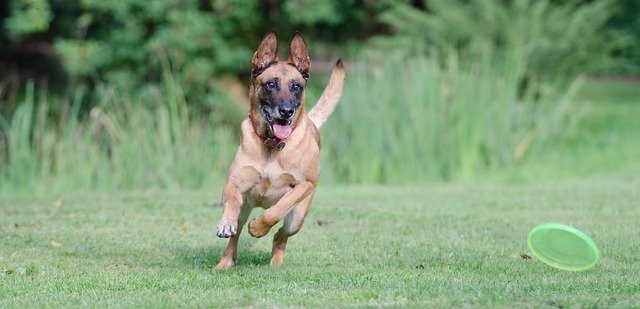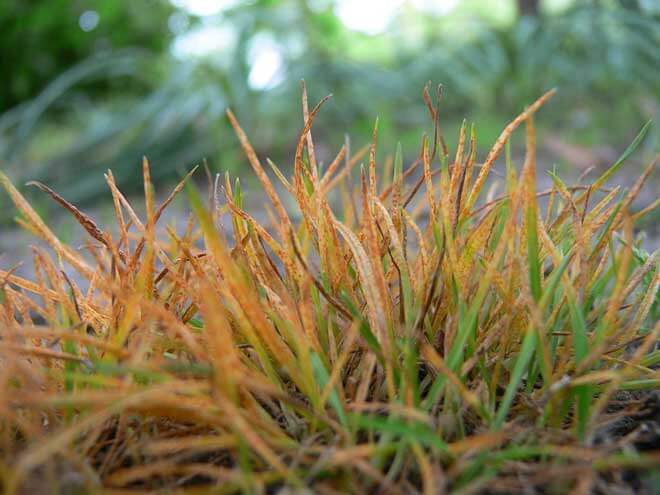Lawn rust is a fungal disease that affects the blades of grass (as well as other plants) in your lawn and it appears as orange or yellow-orange spots on the blades of grass (or leaves of bigger plants).
It can be caused by several fungi types but the commonest causes are Puccinnia coronate (crown rust), Puccinnia Striiformis (yellow stripe rust), and Puccinnia graminis (black stem rust).
The spores of the fungus are spread by wind and water, and they can survive in the soil for long periods.
If your pets walk in infected grass, the lawn’s rust color will transfer to their paws and coat.
But is this harmful beyond making them dirty?
Well, let’s find out…
Is Lawn Rust Harmful To Pets?

For the most part, lawn rust is harmless for both humans and pets, so you have no reason to worry.
That said, some types of rust fungi produce spores that can be inhaled, and in rare cases, this can lead to respiratory irritation in pets.
This is especially true for pets that have allergies because fungi is known to be one of the causes of allergies in pets.
However, this is unlikely to occur unless the pet is actively sniffing or rolling around in an area of the lawn that has a heavy infestation of rust fungi.
If your pet has known allergies, then it is a good idea to keep them away from the lawn as soon as you notice lawn rust.
Otherwise, your dog should just be fine except for the occasional discoloration of their paws, especially if they are brightly colored. But nothing that a good wash can’t fix!
But there is also the danger of opportunistic fungal diseases. These types of infections typically occur in dogs with compromised immune systems, such as those that are elderly, young, or suffering from other health problems.
A common example of an opportunistic fungal disease is Aspergillosis.
Aspergillosis is caused by Aspergillus, a type of mold that is common in the environment.
In dogs, Aspergillosis typically affects the respiratory system, although it can also affect other organs such as the skin and ears.
Dogs with Aspergillosis may experience symptoms such as coughing, sneezing, nasal discharge, and difficulty breathing.
Other possible infections include ringworms and yeast infections.
Treatment for these fungal infections may involve antifungal medications and supportive care, such as oxygen therapy.
However, there is no one-treat-fits-all, so it is a good idea to work with a veterinarian to determine the most appropriate course of treatment for your dog.
How to Keep Your Pets Safe from Lawn Rust

Lawn rust is most commonly found in grasses that are under stress due to insufficient light, poor soil conditions, improper watering, or a lack of nutrients.
It can also be caused by a build-up of thatch (dead grass and other debris) in the lawn, which can create a moist environment that is conducive to the growth of the rust fungus.
This means that the easiest way to control it is by maintaining a healthy and neat lawn.
You can do this by watering it properly, fertilizing it regularly, and removing excess thatch.
If you do notice rust appearing in your lawn, you can also try using a fungicide to help control the spread of the disease.
You may also want to keep your pets away from the lawn until the fungi is gone. This is especially so for older and sick dogs that have weak immunity.
But even the healthier dogs will get brown patches on their paws and coat from the lawn rust, so you may want to keep them away too.
This might mean keeping them indoors as you wait for the fungicide to work.
Fencing off the area may also be alternative although this only works for bigger dog breeds and is also only practical for people that have large fields on their property.
In Summary…
Lawn rust is generally safe for both pets and humans. However, there is a possibility that your pet may get an allergic reaction from the pores that cause the lawn rust or maybe suffer from an opportunistic fungal infection.
This is especially true for older dogs or those that are leaving with an incurable disease because their immunities are usually low.
If that is the case, you will want to keep them away from the lawn until the fungi has been put in check.
Other than that, you do not need to worry about your pet playing in the infected lawn.
Related: How Long Is Wasp Spray Toxic to Dogs?
As an Amazon Associate, we may receive a small commission from qualifying purchases but at no extra cost to you. Learn more. Amazon and the Amazon logo are trademarks of Amazon.com, Inc, or its affiliates.

